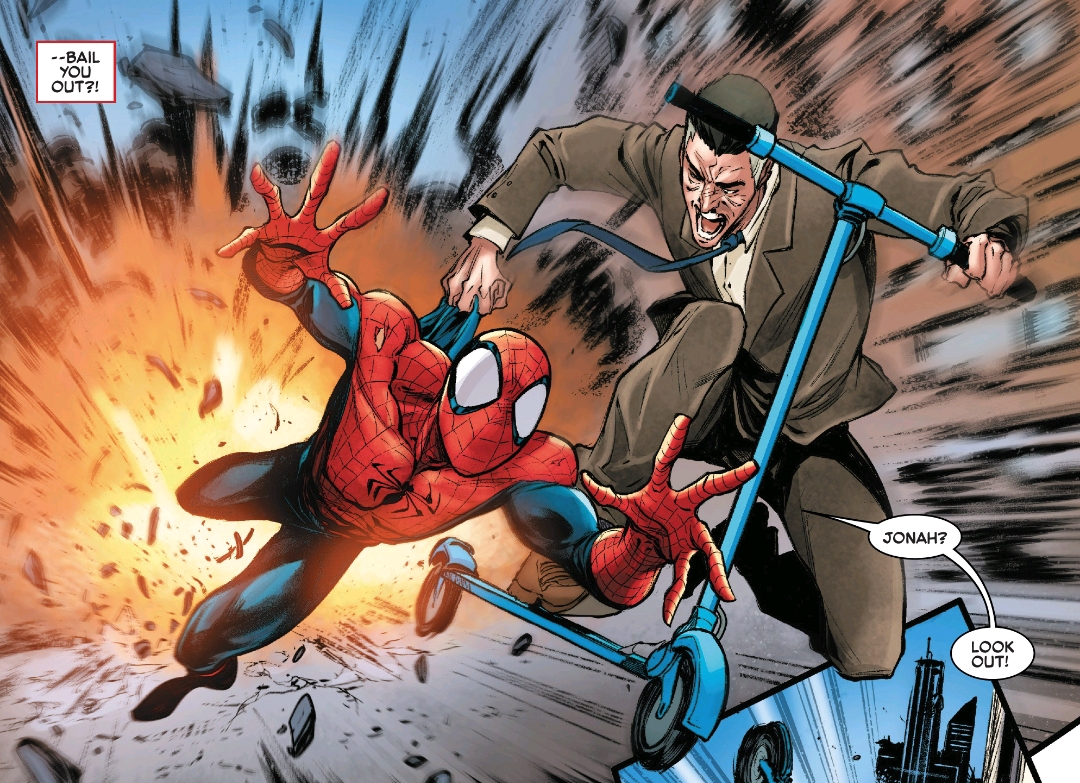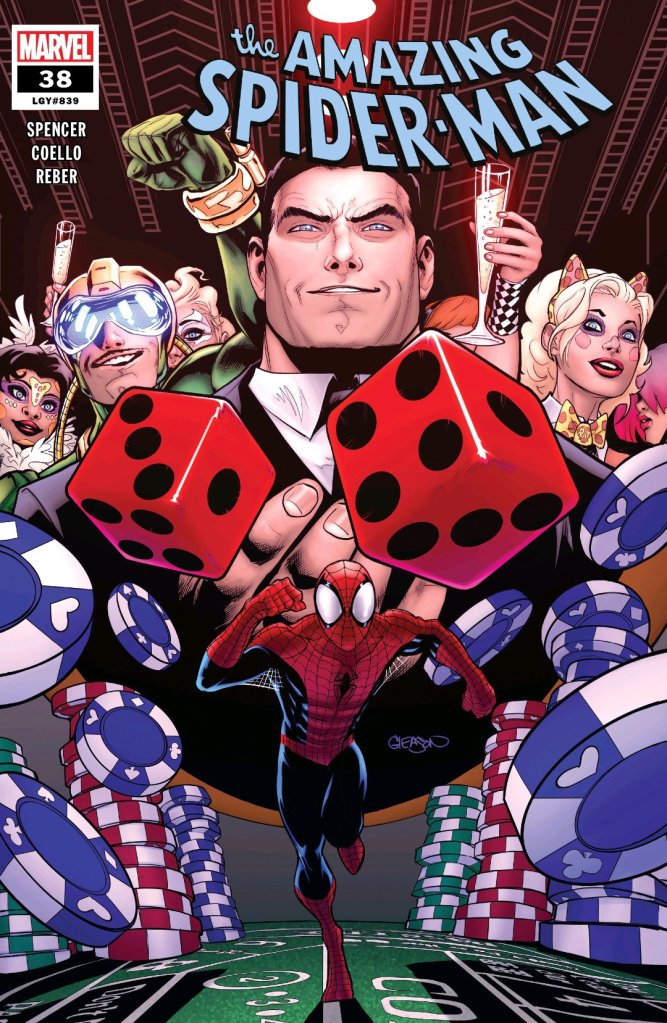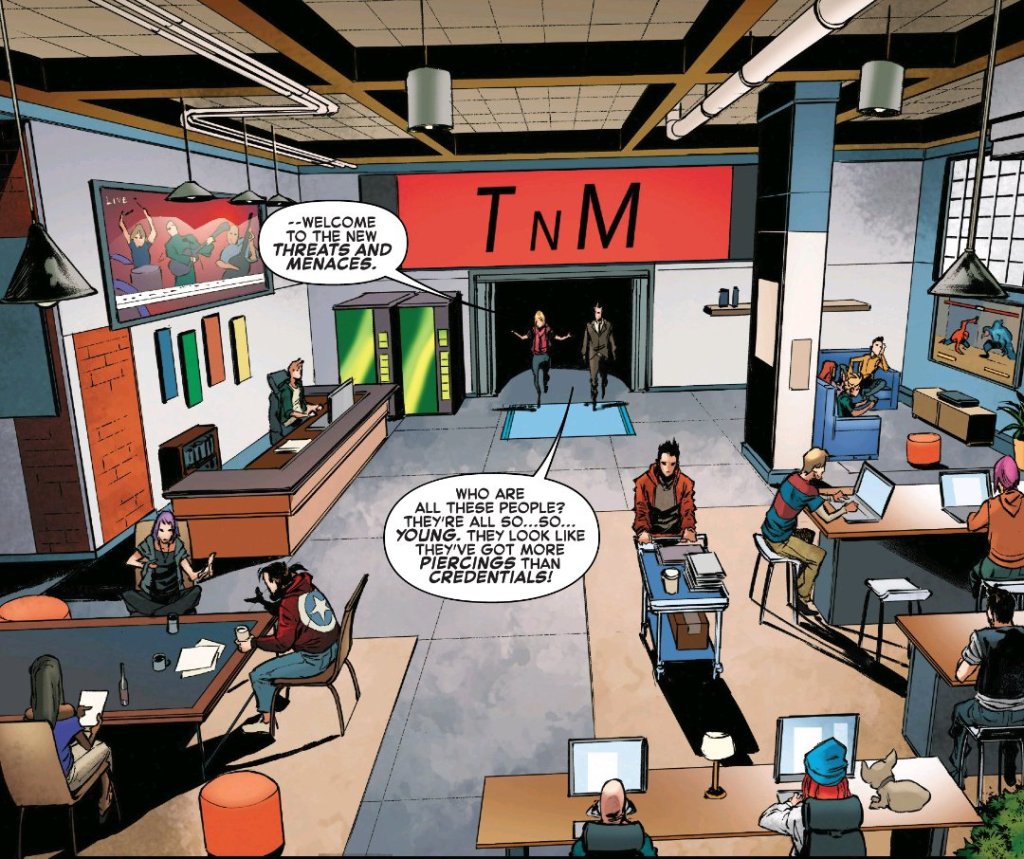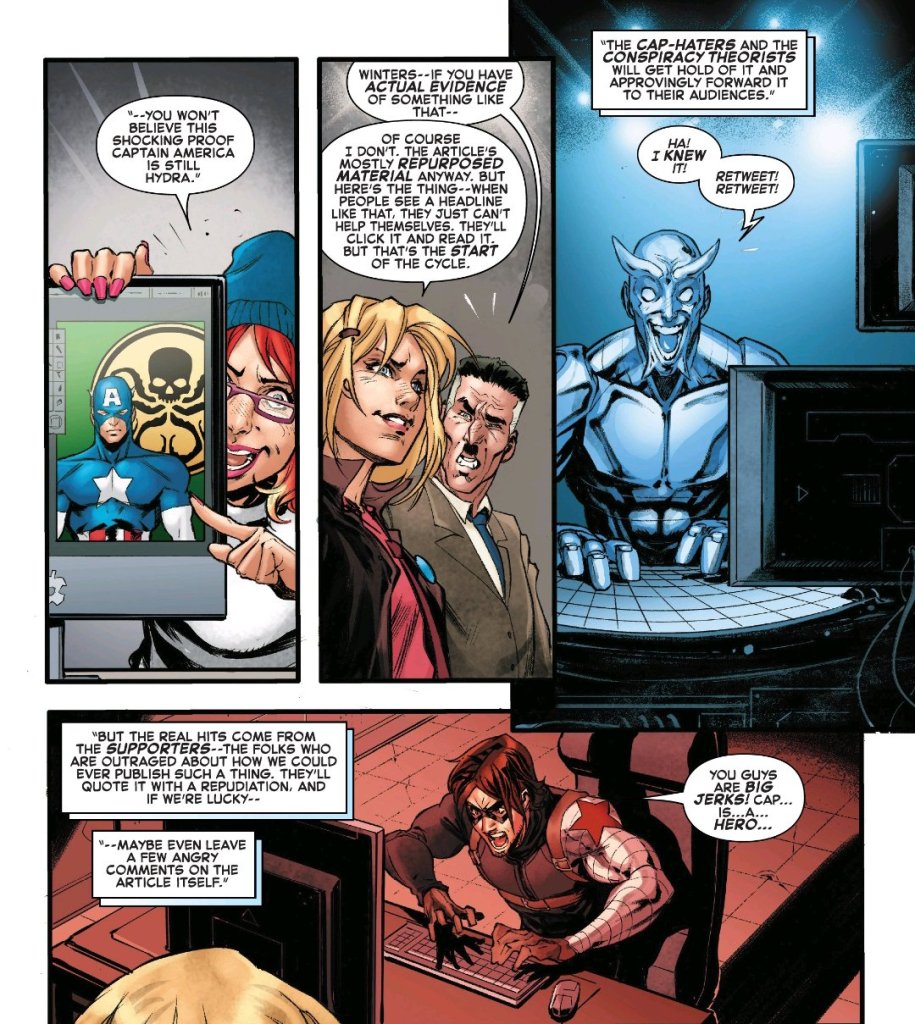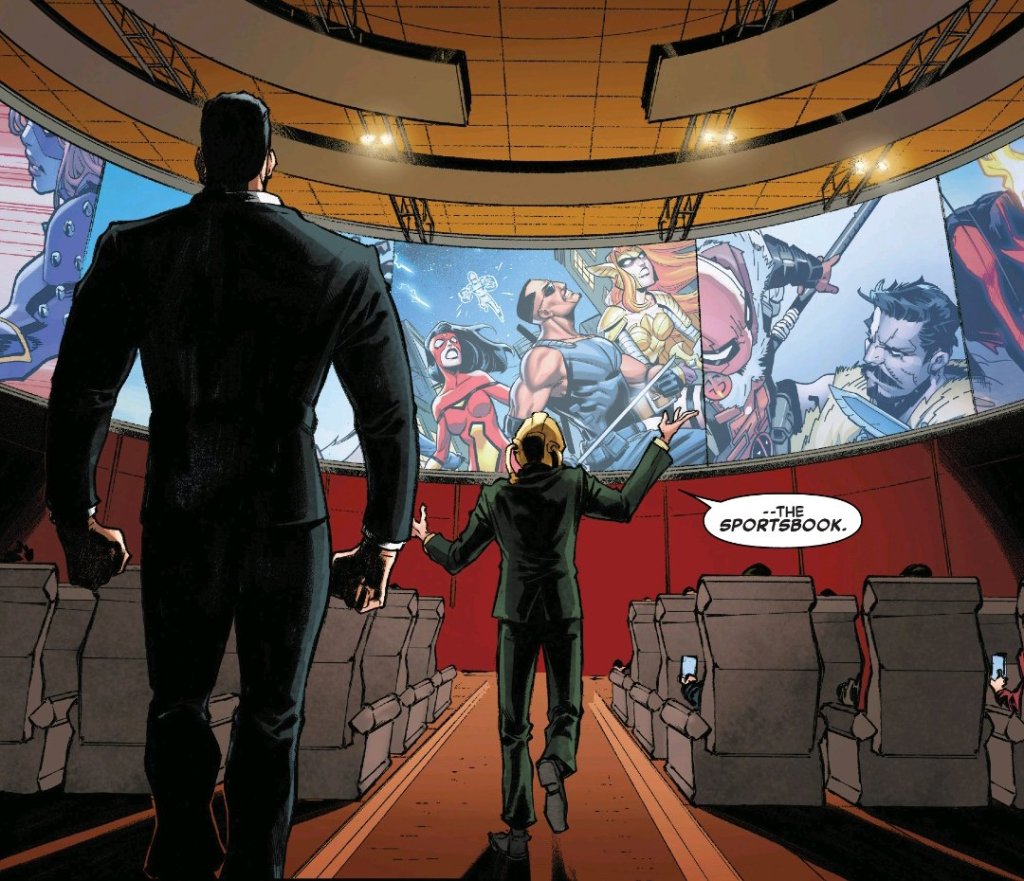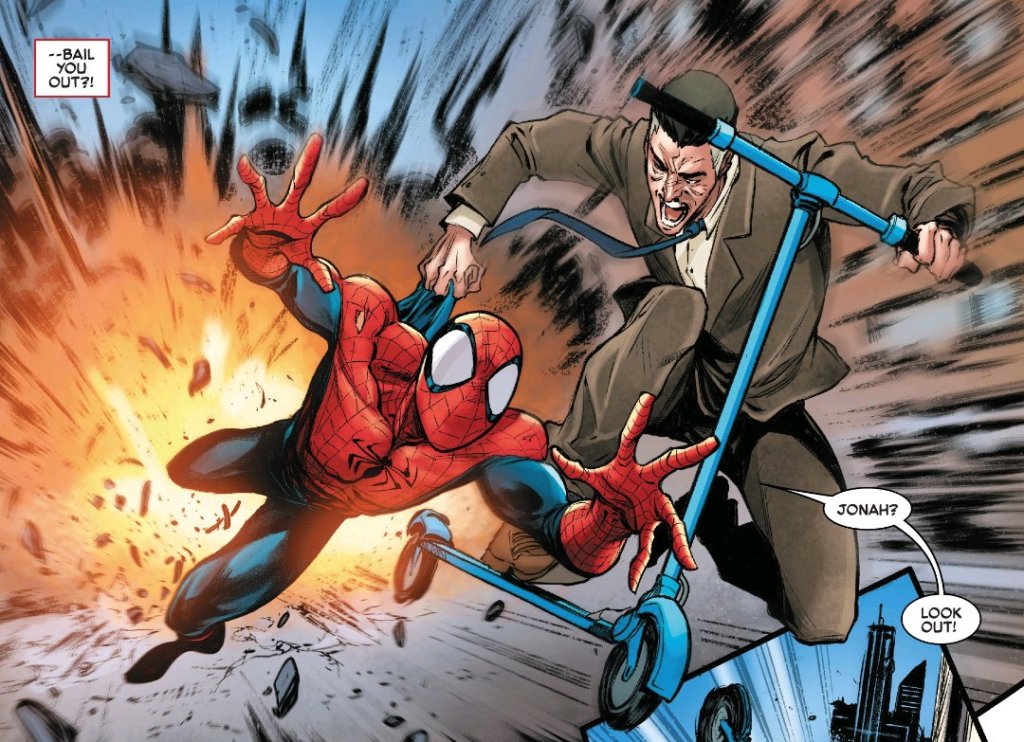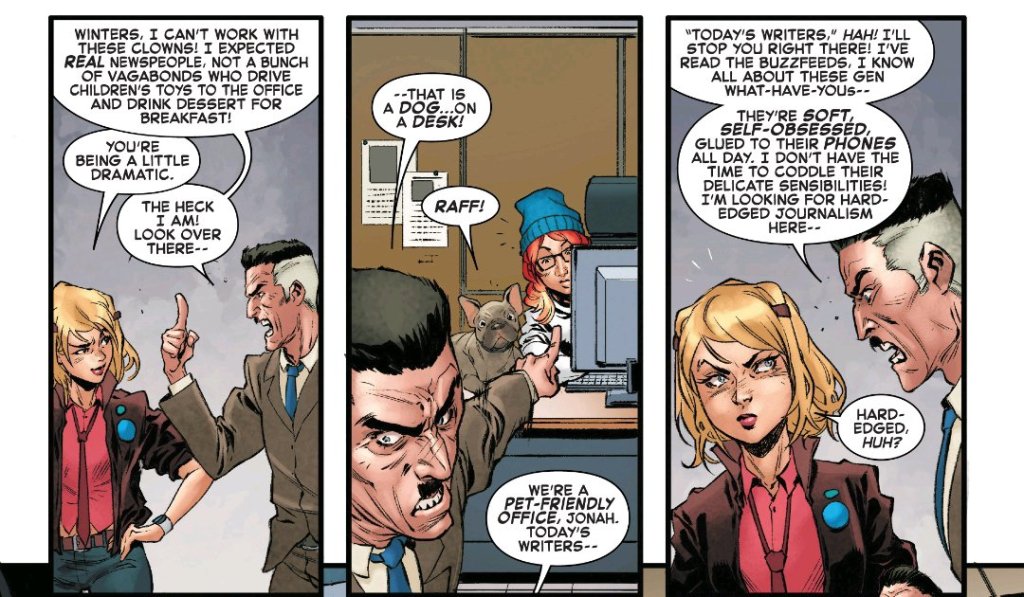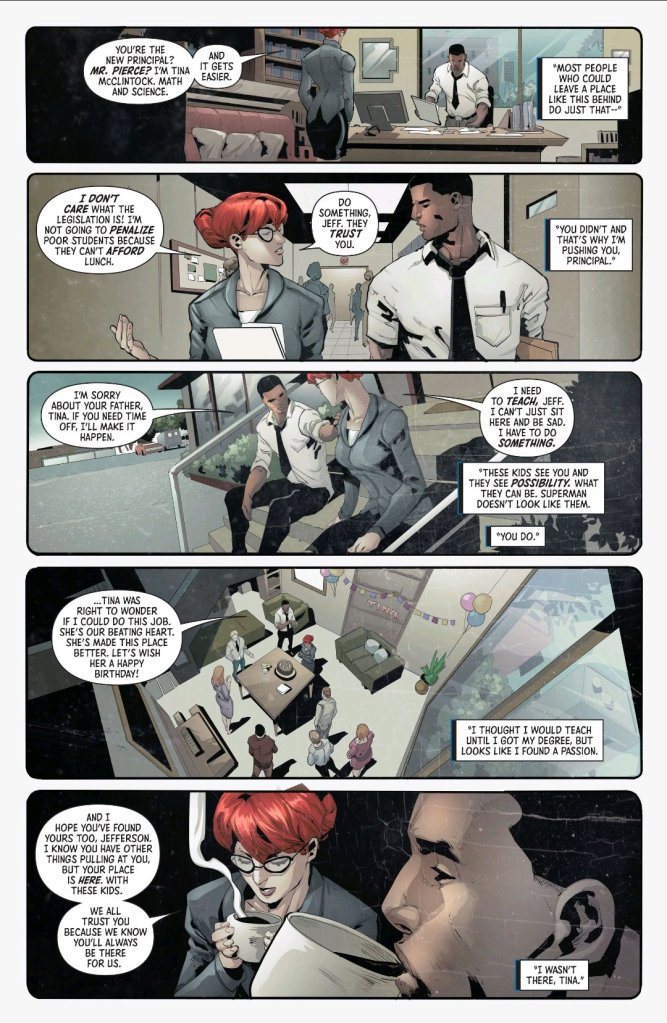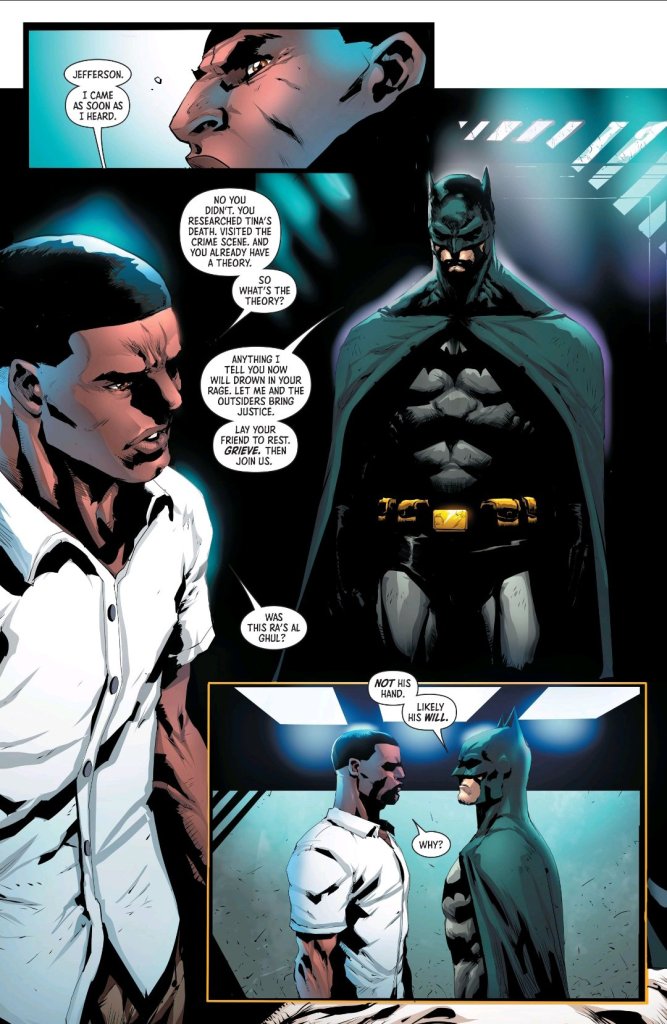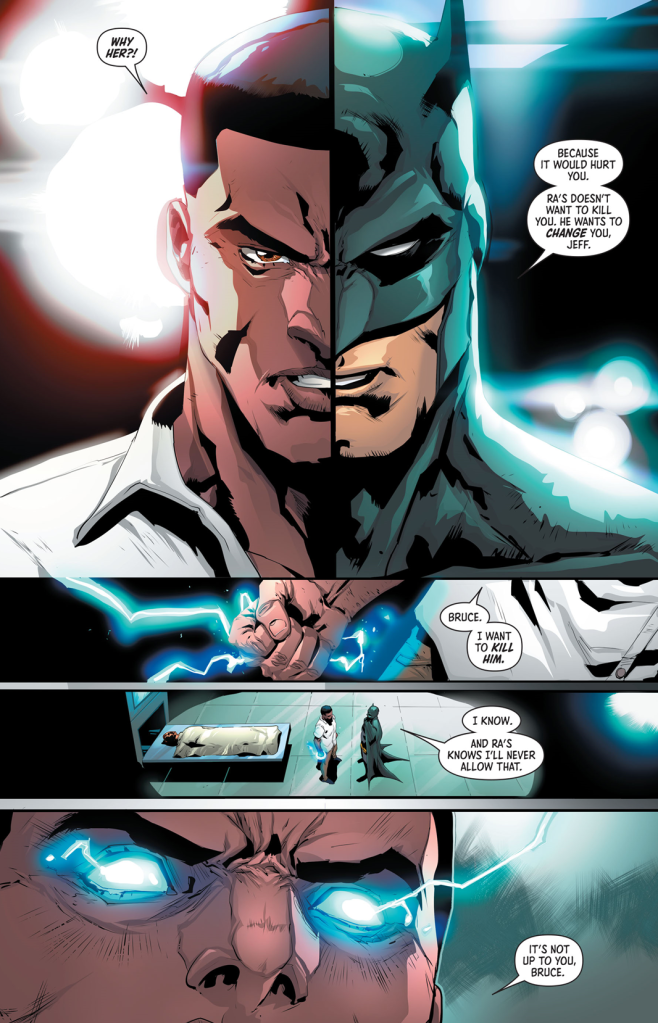Best of this Week: Justice League #39 – Scott Snyder, Jorge Jimenez, Daniel Sampere, Juan Albarran, Alejandro Sanchez, Hi-Fi and Tom Napolitano
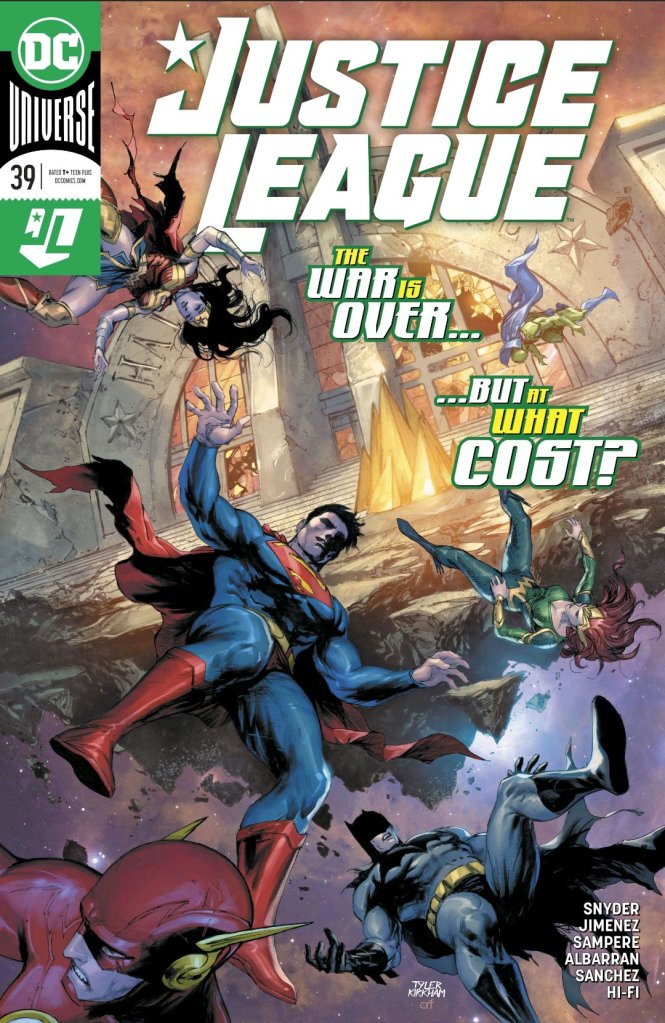
Talk about a Cosmic Sandbag.
Shayne, the alt-future son of Hawkgirl and Martian Manhunter, gave his life and essence so that his father could return from the darkness. This book opens with the amazing return of Martian Manhunter as drawn by Jorge Jimenez with colors by Alejandro Sanchez. Manhuner hasn’t been seen since Justice League #28 when Lex Luthor absorbed him to become Apex Lex, so this return had a monumental feel, especially as the rest of the League looks upon him with awe. Jimenez makes this moment feel powerful as J’onn stands tall against Perpetua with his reds glowing vibrantly thanks to Sanchez.
As soon as Perpetua takes notice that J’onn has returned, she lunges after him. This is likely due to the fact that Martian Manhunter is legitimately one of the most powerful telepaths in the DC Universe and in the subsequent pages, he makes the choice to connect the minds of the people of Earth with his and the rest of the Justice League to try and swing them all toward the side of hope.
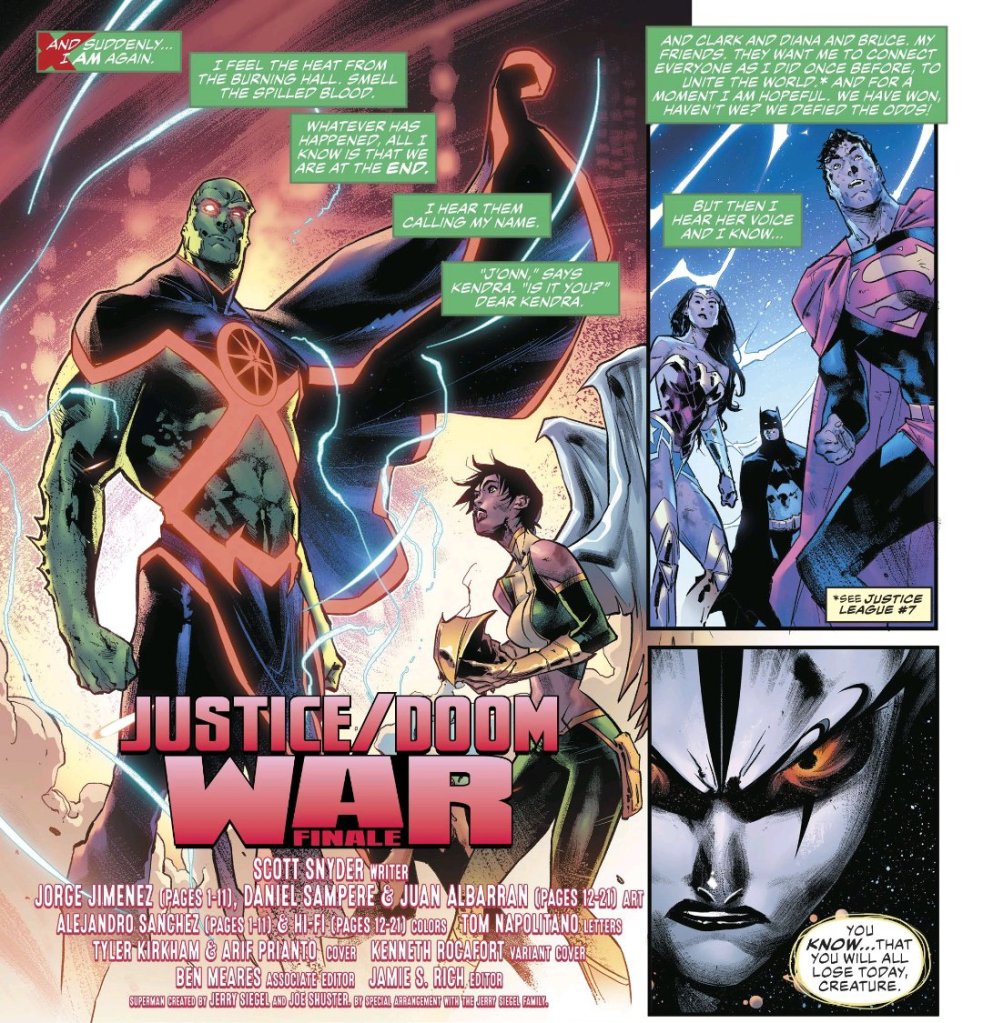
This results in a wonderful double page spread where Jimenez poses Martian Manhunter like he’s about to use the Solar Flare from Dragon Ball and speaks to the people. Jimenez and Sanchez show the people on the streets and various members of the League looking towards the sky with smiles on their faces. Snyder scripts this amazingly by having Manhunter give the rousing speech of goodness and rising above that Superman would normally give. What makes this even better is that Manhunter, who usually suffers disillusionment from living amongst humanity, does an amazing job.
J’onn’s speech manages to rouse enough people that the Totality, the macguffin that could imprison Perpetua once again, begins to glow and surge with energy. Perpetua, starting to feel the fear of loss orders an onslaught of the League. Jimenez emphasizes the anger on her face, the fear on Lex’s and the intensity of the battle happening on the steps of the Hall of Justice.. Sanchez makes sure that the colors almost surge off of the page with flashes of red and blue.
As the hope of the people of Earth continues to grow, the tendrils of the Totality wrap themselves around Perpetua’s spindly body as she screams in anger and hatred. Tom Napolitano places Martian Manhunter’s thought balloons perfectly throughout these pages as Snyder ends J’onn’s speech with the people of Earth joining together in the feeling of heroism and hope. The Sigil of Doom begins to fade away and Perpetua has failed…
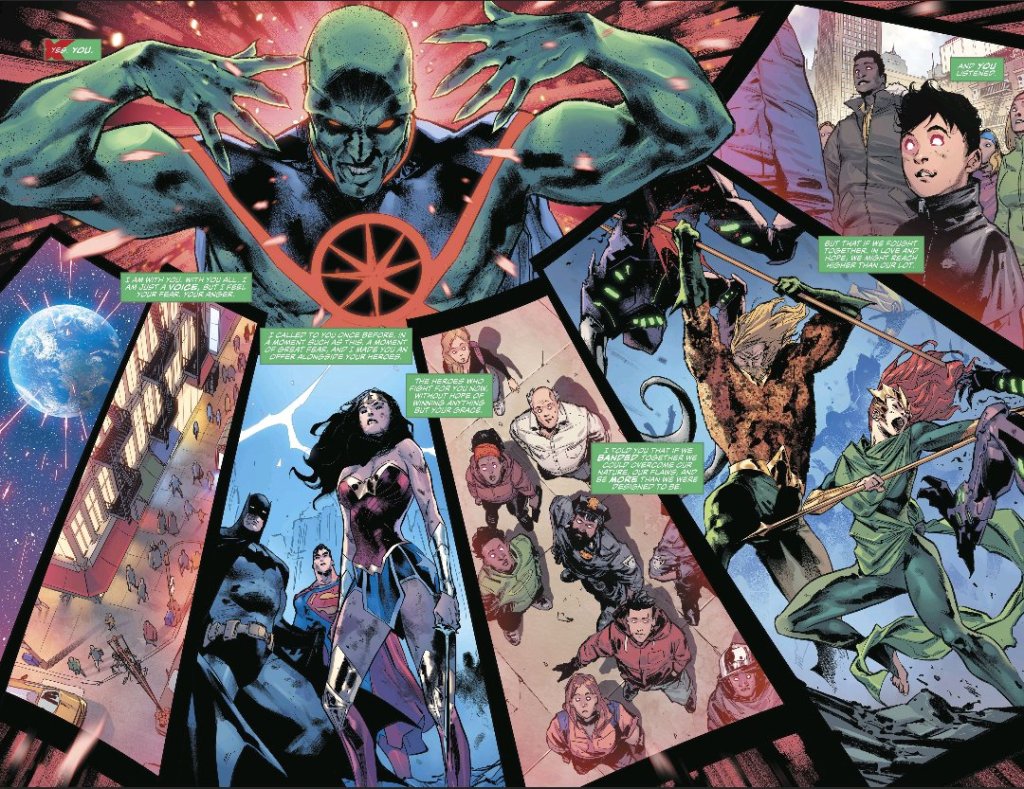
And then “KRA-KOOM,” Napolitano’s powerful lettering cracks across the page as Jimenez draws the Sigil of Doom firmly seared into the sky and made even stronger by the overbearing hum of Sanchez’s vibrant green. This is the kinda trope that Scott Snyder does well, but also kinda overuses in his grand scale stories: The Cosmic Sandbag. The heroes were on the very cusp of victory and it seemed like the people of Earth were actually believing in the hope that Martian Manhunter was talking about, but instead they gave into their fear, hatred and base instincts just like Perpetua thought they would.
Snyder utilizes this bait and switch technique to show just how influential Perpetua’s evil is and how at the end of the day it will take more than just a flowery speech to turn people, especially since they watched the Justice Leagues battle the forces of Doom and lose massively. Snyder used this in Dark Nights: Metal anytime Batman thought he had a chance in defeating The Batman Who Laughs and Barbatos. They would just pull nonsense out of nowhere and further plunge our hero into despair because he couldn’t anticipate the villain’s very next five moves. I love it and hate it because it helps to show hopelessness, which I am a fan of, but Snyder does do it a bit too much for my tastes (See The Batman Who Laughs mini-series).
The next thing we see is a Rita Repulsa-esque cackle from Perpetua and honesty this might be my favorite of Jimenez’s panels because he just makes Perpetua look so petty. She’s basically saying, “Bitch, you really thought!” before explaining how everything was by her design. She wanted to give humanity a choice to hear both sides and they still chose Doom. Manhunter tried to hide his mind from her, but he failed to realize that as the creator of the Multiverse, he could never think fast enough to avoid her. Perpetua is far more powerful than these heroes could ever have anticipated.
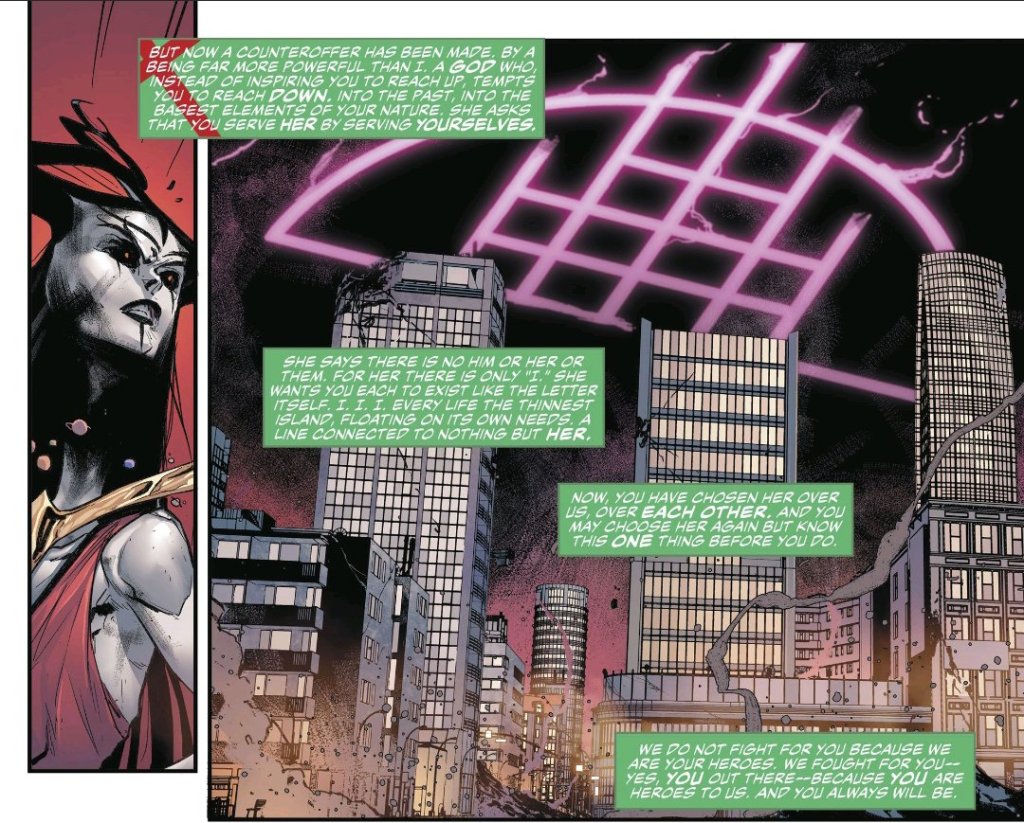
Jimenez and Sanchez absolutely kill the next few panels as Perpetua casts away the shackles of the Totality, breaking out of the tendrils as her black cape…hair(?) causes a gust of wind to shake our heroes while the background shows varying tones of blue, almost a mockery of their ideals of hope. She stands over the Earth while the void of space appears vast around it and with a flick of her wrist and a flash of yellow she wipes the Justice League from existence. Doom truly has won and she vows to create a new story from the ashes of Hope.
Though, the universe itself has other ideas. In the black of Space, green matter begins to coalesce into a form, then that form takes shape and appears to be Martian Manhunter. Daniel Sampere, Hi-Fi and Juan Albarran take over the art from this point and pose Manhunter as if he’s in a womb, reborn after being supposedly killed by Perpetua and saved by something else. I love that Snyder places such importance on Manhunter and his humanity. Despite the insurmountable odds that the League has faced up to this point, he still does everything in his power to call back to the Earth, to try to win the people back.
He is unable to, however, and it seems as though he’s not the only one unable to use his powers as the rest of the League shows up behind him. In an awesome splash page Sampere and Albarran show everyone as wearing black bodysuits, potentially symbolizing a loss of identity or power as none of them seem to be able to use their abilities. Hawkgirl seems to be the only exception because her wings are a part of her. Superman tries to rationalize that as long as they’re not actually dead then there’s still hope, but then he fails to fly, landing back on the moon.
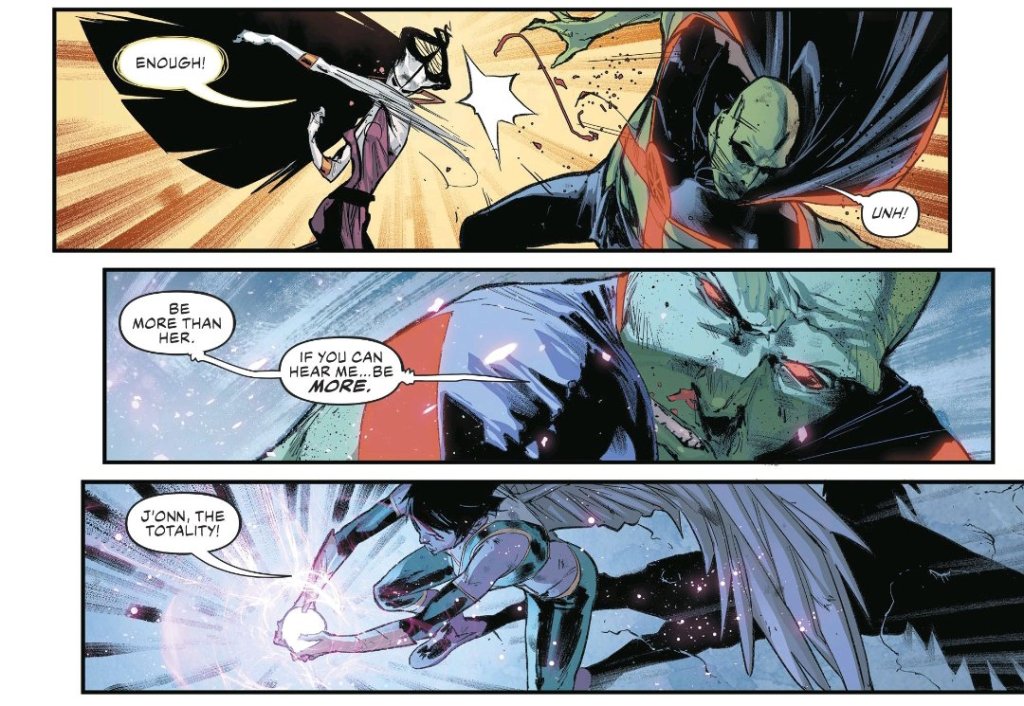
Another awesome thing about this issue is how it calls back to the very first issue of the run with the Quintessence showing up. The Quinessence are a group consisting of Highfather, The Phantom Stranger, Hera, The Wizard Shazam, The Spectre and Ganthet of the Guardians of Oa. They are some of the most powerful beings in the universe and even they knew that this was how things were meant to be. They saw the same vision of Doom that Martian Manunter did and saved the League in the nick of time to prepare them for what’s to come, not just a war of Justice or Doom, but for Everything.
With everything that’s been hinted at as far as the next incoming Crisis, this is a really good inciting incident as far as things go. Perpetua wins and sets up the next true war for the Multiverse. Given there’s still things to sort out with The Batman Who Laughs, the conflict is set and the Justice League has to give their all to ensure that they can protect the Universe. Superboy Prime is coming back in the pages of Shazam, Wally West has found his kids and Dark Multiverse world of his own creation and this issue even references Doomsday Clock and kinda cements its place as an alt-Universe story, but acknowledges the importance of it.
Scott Snyder has set the stage for everything to come and thanks to his fantastic art team telling the story, he drums up the feeling that there’s still a way to see Geoff Johns original vision for Rebirth through. The hope is there, the League just needs to fight for it. I can’t wait to see what Robert Venditti can do as the writer for Justice League given the amazing work he’s done with Green Lantern and The Freedom Fighters series. Doug Mahnke also taking over as main artist is also a welcome change as he’s one of my favorite of DC’s regulars as well.

This was a high recommend and I can’t wait for the future!

